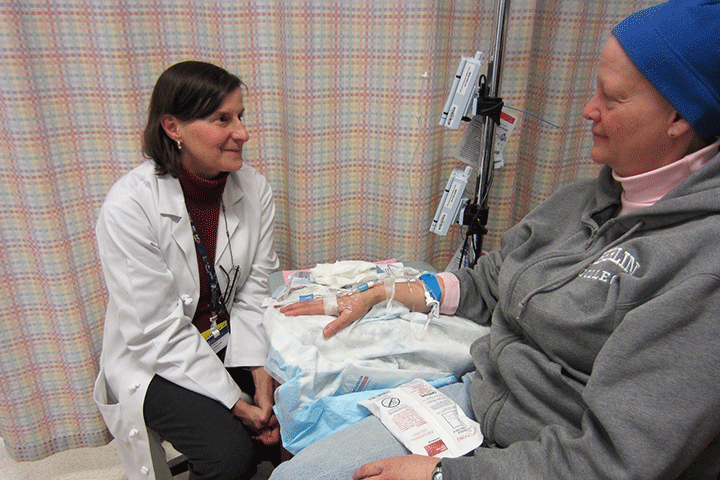Stay Fit During Cancer Treatment

If you’re newly diagnosed with pancreatic cancer, or navigating a grueling treatment schedule, getting in shape may not be at the top of your mind.
After all, in the wake of a life-changing diagnosis, who has time for exercise? You do! Studies show that exercise during treatment not only increases energy levels and boosts mood, but it also promotes better sleep.
Even though scientists don’t have data to suggest that exercise improves prognosis or reduces recurrence for pancreatic cancer patients (they’re working on it!), Harvard Medical School (Boston) professor Christina Dieli-Conwright, Ph.D., M.P.H., says that maintaining muscle mass and strength or physical fitness during cancer treatment may dramatically improve quality of life for pancreatic cancer patients.
The Exercise Challenge
When you’re undergoing pancreatic cancer treatment, myriad factors converge to make exercise a challenge. Unlike other solid tumors, pancreatic cancer may present complications that impact your ability to eat and maintain a healthy weight. To make matters more complex, you may also face nutrient deficiencies, pain, and fatigue.
If you’re exhausted and malnourished, it’s natural to plant yourself on the couch and wait for the storm to pass. Unfortunately, that’s the worst thing you can do, in part because a body at rest tends to stay at rest. “When you’re malnourished and sedentary, you lose muscle mass quickly,” says Dieli-Conwright, “and that’s a problem, since low skeletal muscle mass is linked to a number of poor outcomes, including increased mortality.”
Prehabilitation Basics
Prehabilitation, or exercising before undergoing treatment for cancer, such as surgery or chemotherapy, could help you recover more quickly. There’s even research to suggest that conditioning your body prior to undergoing surgery or cancer treatment can boost your odds of survival.
Unfortunately, there isn’t a large body of research on prehabilitation exercise for pancreatic cancer patients. However, studies on prehabilitation for other solid tumors suggest that patients who are the most fit at the start of treatment do better over the long haul.
“I view prehabilitation almost like training for a race or a competition, but in this case, the event is the patient’s treatment plan,” Dieli-Conwright explains. In fact, she is so convinced of the benefits of exercise on patients’ health and quality of life that she is currently recruiting pancreatic cancer patients to participate in a study investigating the role of resistance exercise during pancreatic cancer treatment.
Resistance Training during Treatment
Studies consistently link physical activity before, during, and after cancer treatment with a slew of benefits—both physical and emotional. But research is lacking on the benefits of specific types of activity, particularly for pancreatic cancer patients.
With funding from Friends of Dana Farber, Dieli-Conwright and her team are recruiting pancreatic cancer patients who are in active treatment to participate in a resistance training program that includes three weekly sessions of guided, stepwise resistance training with the goal of maintaining muscle mass.
While the results of the study won’t be available for six to 12 months, there’s little doubt that resistance training can produce a host of benefits for pancreatic cancer patients. “Resistance exercise can have dramatic effects on quality of life, from improving activities of daily living to enhancing cardiorespiratory fitness and muscle endurance,” she notes.
Tips to Maintain Muscle Mass
Unfortunately, most patients don’t know where to start when it comes to resistance training, especially if they’re currently in treatment. The good news: Building and maintaining muscle mass doesn’t have to be difficult. Dieli-Conwright offers a few tips to help you get started:
- Keep it simple. If you’re already exercising, try to maintain your fitness level. Sure, you may have to scale back on your usual regimen, but do your best to stick to your weekly routine.
- Do something. If you’re not feeling it, commit to doing something small, even if that means interrupting sedentary time by standing up or walking down the hallway. Getting some exercise, no matter how little, will always be better than none.
- Mix things up. It’s not uncommon for people to stick with only aerobic exercise, particularly during cancer treatment. They might go for a walk, hike, or take a bike ride but neglect strength-training activities. But when it comes to maintaining—and building—muscle mass, you’ll get the most bang for your buck when you incorporate resistance training.
- Work with a professional. With resistance exercise, knowing what to do and how to do it safely can be difficult, especially if you require adaptive equipment. Don’t be afraid to ask your doctor to refer you to an exercise specialist or resources in your geographic area. These professionals can create a custom exercise program that targets your unique needs and abilities.
- Use your body weight. Don’t underestimate the power of your own body weight to boost your fitness level. Do push-ups on a wall, squats while holding onto a chair, or bring yourself to standing from a seated position. Every move you make that requires strength will help your body maintain strength and perhaps recover more quickly.





